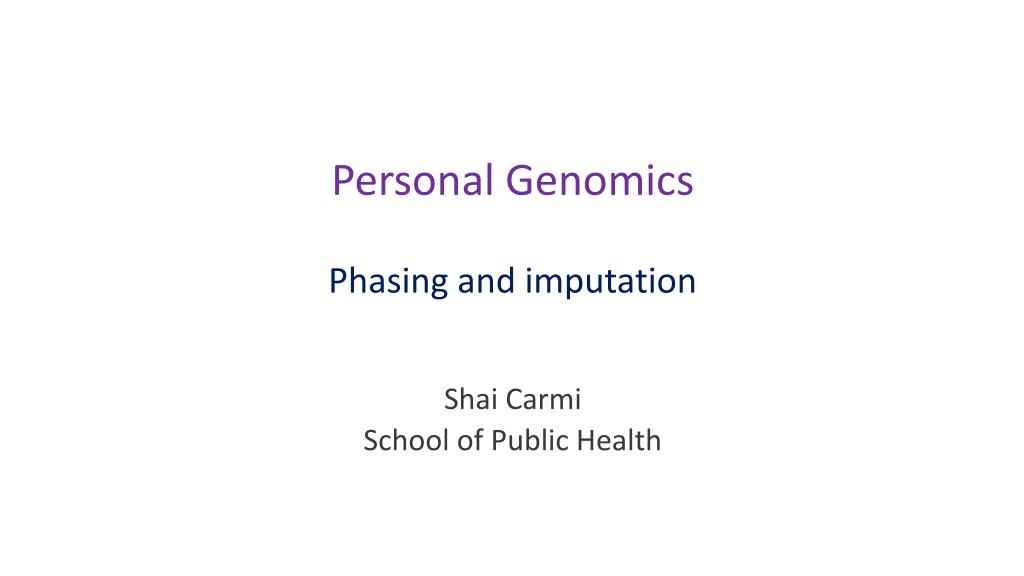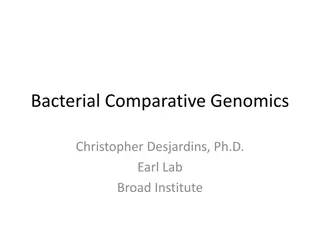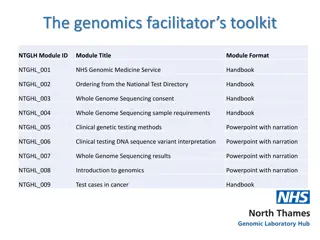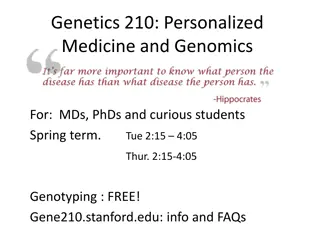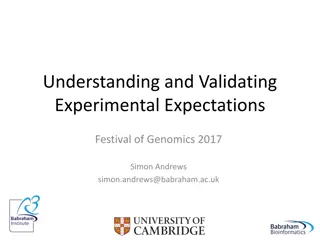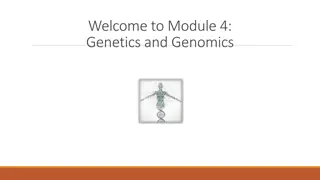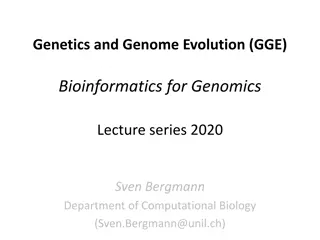Understanding Phasing in Personal Genomics
Phasing in personal genomics involves resolving haplotypes from diploid genotypes to identify associations with diseases, compound heterozygosity, shared haplotypes, and ancestral origins. It helps in detecting relatives, historical recombination events, and haplotypes under selection. Different types of phasing methods include family phasing, statistical phasing, and experimental phasing. Family phasing involves trio analysis to determine transmitted and non-transmitted haplotypes. Trio phasing is the gold standard, but ambiguity may persist even with additional family members. Statistical phasing relies on homozygous individuals to infer haplotypes due to linkage disequilibrium along the genome.
Download Presentation

Please find below an Image/Link to download the presentation.
The content on the website is provided AS IS for your information and personal use only. It may not be sold, licensed, or shared on other websites without obtaining consent from the author. Download presentation by click this link. If you encounter any issues during the download, it is possible that the publisher has removed the file from their server.
E N D
Presentation Transcript
Personal Genomics Phasing and imputation Shai Carmi School of Public Health
Phasing The natural units of genetic material are haploid chromosomes or haplotypes However, genotyping/sequencing gives us diploid genotypes Can we resolve the actual haplotypes? Called phasing Genotypes CC, GG, AG, CC, GG, CT, AA, CC Haplotype ? CGGCGCAC CGACGTAC CGACGCAC CGGCGTAC
Why phasing? Test whether a specific combination of alleles is associated with a disease Look for compound heterozygosity Look for shared haplotypes o Detect close relatives o Detect remote relatives (and thereby historical population demography) o Determine the ancestry of chromosomes o Identify historical recombination events o Detect haplotypes under selection Healthy Sick Healthy Sick Consider a gene that needs at least one functional copy to work
Types of phasing Family phasing Statistical phasing Experimental ( physical , or read-based ) phasing
Family phasing Usually we consider trios: mother, father, and child At the child, we resolve paternal and maternal haplotypes At the parents, we resolve transmitted and non-transmitted haplotypes AB BB AB AB AB AA AA AA AA AB AA AB Mother transmitted A A A A Mother non-trans A A B A Father transmitted A B A B Father non-trans B A B B Child maternal A A A A Child paternal A B A B
Trio phasing Trio phasing is considered gold standard Phasing can improve with additional family members (e.g., siblings) But the phase can remain ambiguous even with trios or larger families AB AB AB AB AB
Statistical phasing For each single target genome, no information is available to allow phasing But we can look for other individuals who are homozygous to the same haplotypes! Homozygous individuals have two copies of the same haplotype, so no ambiguity Even when there is one het, there is no ambiguity The presence of a haplotype in one individual does not guarantee that the same haplotype will be found in another But it is quite likely, due to linkage disequilibrium (correlation along the genome) o More later
Basic statistical phasing Divide the genome into windows Example: Clark s Algorithm SNP 1 SNP 2 SNP 3 SNP 4 SNP 1 SNP 2 SNP 3 SNP 4 Ind 1 hap 1 A C G G Ind 1 AA CC GG GG Ind 1 hap 2 A C G G Ind 2 AA CG GG GG Ind 2 hap 1 A C G G Ind 3 AT CT GG GG Ind 2 hap 2 A G G G Ind 4 AA CT GG GT Ind 3 AT CT GG GG Ind 4 AA CT GG GT Haplotype bank : ACGG, AGGG How to phase individual 3?
Basic statistical phasing Individual 3 could be (ACGG, TTGG) or (ATGG, TCGG) ACGG is already in the bank , so first option is chosen Haplotype bank : ACGG, AGGG SNP 1 SNP 2 SNP 3 SNP 4 SNP 1 SNP 2 SNP 3 SNP 4 Ind 1 hap 1 A C G G Ind 1 hap 1 A C G G Ind 1 hap 2 A C G G Ind 1 hap 2 A C G G Ind 2 hap 1 A C G G Ind 2 hap 1 A C G G Ind 2 hap 2 A G G G Ind 2 hap 2 A G G G Ind 3 hap 1 A C G G Ind 3 AT CT GG GG Ind 3 hap 2 T T G G Ind 4 AA CT GG GT Ind 4 AA CT GG GT The updated bank: ACGG, AGGG, TTGG
Basic statistical phasing Individual 4 could be (ACGG, ATGT) or (ACGT, ATGG) ACGG is already in the bank , so first option is chosen Bank: ACGG, AGGG, TTGG SNP 1 SNP 2 SNP 3 SNP 4 SNP 1 SNP 2 SNP 3 SNP 4 Ind 1 hap 1 A C G G Ind 1 hap 1 A C G G Ind 1 hap 2 A C G G Ind 1 hap 2 A C G G Ind 2 hap 1 A C G G Ind 2 hap 1 A C G G Ind 2 hap 2 A G G G Ind 2 hap 2 A G G G Ind 3 hap 1 A C G G Ind 3 hap 1 A C G G Ind 3 hap 2 T T G G Ind 3 hap 2 T T G G Ind 4 hap 1 A C G G Ind 4 AA CT GG GT Ind 4 hap 2 A T G T
Advanced statistical phasing Clark s algorithm can get stuck, if none of the possible haplotypes is in the bank It could be that in both options, the haplotypes exist in the bank It also does not distinguish between frequent and rare haplotypes Assume known Browning and Browning, 2011
Advanced statistical phasing A useful idea is to estimate haplotypes iteratively Make a rough guess of all haplotypes except one Then estimate the target haplotypes based on the current guess Re-iterate through all genomes Current popular methods: Beagle, Shapeit, Eagle, Mach
Measuring phasing errors To evaluate accuracy, need to benchmark against trio or experimental phasing The common measure of performance is the switch error rate: ?/(? 1) o ?: number of heterozygous sites in the individual o ?: number of switches Typical SER for current methods: 1/100 True haplotypes A G T C T A G G G A T C C A A G C A A A C T C G A C T T C C A A T G C G A C T G A G C C ? = 13 Inferred haplotypes A G T C T A C C A A T G C G A G C A A A C T C G A C T T G G G A T C C A A C T G A G C C ? = 2
Experimental phasing In microarrays, each SNP is genotyped independently In sequencing, the basic unit is a read ( 50-100bp) In some cases, two or more hets fall on the same read Other approaches: Sequence gametes (oocytes/sperm) Molar pregnancy True haplotypes A G T C T A G G G A T C C A A G C A A A C T C G A C T T C C A A T G C G A C T G A G C C Reads A G G G A T C C A A G T C T A G G G A C G A C T T C C A C C A A T G C G C C A A G C A A A C T
Experimental phasing Experimental phasing is particularly important for rare variants When paired-end reads are available, accuracy improves significantly About a third of pairs of het sites can be phased using standard WGS Choi et al., PLOS Genet, 2018 The longer the reads, the higher the accuracy of experimental phasing In the extreme, entire chromosomes are sequenced individually, by physically separating the two chromosomes in each cell (more later)
What about the missing variants? Microarrays are 20x cheaper than WGS, but only cover 1M sites out of 3B While the selection is educated (polymorphic/important sites), many variants remain uncovered Fortunately, this is in many cases good enough! The genotyped SNPs are linked to ungenotyped SNPs Linkage = correlation Also called linkage disequilibrium (LD)
Why linkage disequilibrium? Mutations that remain on the same haplotype throughout the generations are in LD LD is usually incomplete: two alleles appear together more than by chance, but not always LD is lost with time and distance between SNPs
Why is it important? We often search for variants that increase the risk of disease Even if the causal variant is uncovered by the array, if it is in LD (=correlated) with an array SNP, an association with the disease will be detected The detected SNP is called a tag SNP In fact, if we have full sequence reference data, it is possible to infer the genotypes of uncovered variants Called imputation
Basic idea Divide the genome into windows Collect a set of previously phased fully sequenced reference haplotypes For each window, detect the reference haplotype most similar to the target genome, only based on the array SNPs Infer the genotypes at ungenotyped SNPs according to the reference sequence
Basic idea Haplotype SNP 1 SNP 2 SNP 3 SNP 4 SNP 5 SNP 6 SNP 7 1 0 1 1 0 0 1 1 Sequenced and phased reference haplotypes 0 1 1 1 0 0 1 2 0 0 1 1 1 0 0 3 0 1 1 0 0 0 1 4 0: ref allele 1: alt allele 1 0 1 0 0 1 0 5 1 1 0 1 1 0 0 6 Haplotype SNP 1 SNP 2 SNP 3 SNP 4 SNP 5 SNP 6 SNP 7 Genotyped (microarray) 0 1 0 1 1 ? ? ? 1 1 0 0 2 ? ? ?
Basic idea Haplotype SNP 1 SNP 2 SNP 3 SNP 4 SNP 5 SNP 6 SNP 7 1 1 1 1 1 Sequenced and phased reference haplotypes 0 1 1 1 2 0 1 1 0 3 0 1 0 1 4 1 1 0 0 5 1 0 1 0 6 Haplotype SNP 1 SNP 2 SNP 3 SNP 4 SNP 5 SNP 6 SNP 7 0 1 0 1 Genotyped 1 ? ? ? 1 1 0 0 2 ? ? ?
Basic idea Haplotype SNP 1 SNP 2 SNP 3 SNP 4 SNP 5 SNP 6 SNP 7 1 0 1 1 0 0 1 1 Sequenced and phased reference haplotypes 0 1 1 1 0 0 1 2 0 0 1 1 1 0 0 3 0 1 0 1 4 1 0 0 1 0 1 0 0 1 0 5 1 1 0 1 1 0 0 6 Haplotype SNP 1 SNP 2 SNP 3 SNP 4 SNP 5 SNP 6 SNP 7 0 1 0 1 Genotyped 1 1 0 0 1 1 0 0 2 ? ? ?
Basic idea Haplotype SNP 1 SNP 2 SNP 3 SNP 4 SNP 5 SNP 6 SNP 7 1 1 1 1 1 Sequenced and phased reference haplotypes 0 1 1 1 2 0 1 1 0 3 0 1 0 1 4 1 1 0 0 5 1 0 1 0 6 Haplotype SNP 1 SNP 2 SNP 3 SNP 4 SNP 5 SNP 6 SNP 7 0 1 0 1 Genotyped 1 1 0 0 1 1 0 0 2 ? ? ?
Basic idea Haplotype SNP 1 SNP 2 SNP 3 SNP 4 SNP 5 SNP 6 SNP 7 1 0 1 1 0 0 1 1 Sequenced and phased reference haplotypes 0 1 1 1 0 0 1 2 0 0 1 1 1 0 0 3 0 1 1 0 0 0 1 4 1 1 0 0 5 0 0 1 1 1 0 1 1 0 0 6 Haplotype SNP 1 SNP 2 SNP 3 SNP 4 SNP 5 SNP 6 SNP 7 0 2 2 1 Genotyped 1 1 0 0 1 1 0 0 2 0 0 1
Imputation practice Imputation is not exact! We may not have a close enough haplotype in the reference Different rare variants may accumulate on the different branches Imputation accuracy usually decreases with the minor allele frequency Common tools: IMPUTE2, Minimach
The Haplotype Reference Consortium (HRC) The larger the reference panel, the higher the accuracy HRC: 64,976 haplotypes at 39M SNPs with 5 minor alleles Accuracy is measured as the squared Pearson correlation between true and imputed genotypes Everyone can impute their genomes online o https://imputation.sanger.ac.uk/ o https://imputationserver.sph.umich.edu/
Matching ancestries It was shown that imputation is much more accurate if the reference panel contains genomes with ancestry matched to the target Ashkenazi Jews Netherlands
Whats still missing? All the algorithms we have so far described work by dividing the genome into windows But... How to choose the window size and boundaries? How to avoid discontinuities between windows? It is better to avoid windows altogether, using Hidden Markov Models (HMM)
Hidden Markov Models Idea: at each time point, the system is in one of a number of states We can t see the states, but we see observations that depend on the state 0.7 0.05 0.95 0.3 Depressed Normal 0.1 0.3 0.5 0.6 0.4 0.1 Juice Vodka Beer
Hidden Markov Models Suppose we are bartenders, and we observe the drink ordered each day: o Beer, Juice, Juice, Vodka, Beer, Vodka, Beer, Vodka, Juice, Juice, Beer, Juice Can we estimate what was the state each day, based on the observations? Can we say whether one sequence of drinks is more likely than another? o Is it likely to have Juice, Vodka, Juice, Vodka, Juice, Vodka, Can we estimate the probabilities of states and observations given a sequence?
Definitions Probabilities to move between states: transition probabilities Probabilities of observations given states: emission probabilities 0.7 0.05 0.95 0.3 Transition probabilities Depressed Normal 0.1 0.3 0.5 0.6 0.4 0.1 Emission probabilities Juice Vodka Beer
Why Markov? ?? 1 ?? ??+1 States (hidden) Data (observed) ?? 1 ?? ??+1 Generally used to model sequential data (e.g. time series, genome) The state at time ?, ??, depends only on the state at time ? 1, ?? 1 The current state depends only on the previous state, not the entire history Markov property The observation at time ?, ??, depends only on the hidden state at that time, ??
Definitions We focus on the following problem: given a sequence of observations, what is the most likely sequence of states? Formally, the number of states is ? and the number of possible observations is ? o In the example, ? = 2 (normal, depressed) and ? = 3 (juice, beer, vodka) The transition probabilities are ???, for ?,? = 1, ,? o In the example, ?11= 0.95, ?12= 0.05, ?21= 0.3, and ?22= 0.7 The emission probabilities are ??(?), for ? = 1, ,? and ? = 1, ,? o In the example, ?1(1) = 0.6, ?1(2) = 0.3, ?1(3) = 0.1, ?2(1) = 0.1, ?2(2) = 0.4, and ?2(3) = 0.5
Definitions The number of time points is ? o In the example, ? = 12 The hidden states are ?? and the observations are ??, for ? = 1, ,? The probabilities to be in each state at ? = 1 are ??, for ? = 1, ,? o In the example, assume ?1= 0.9 and ?2= 0.1 The most likely sequence of states is obtained by the Viterbi algorithm
The nave solution Before learning the Viterbi algorithm, is there a trivial solution? Na ve algorithm: go over all sequences of states For each sequence, ?1?2, ,??, compute its probability: ? = ??1??1?1??1?2??2?2 ??? 1??????? Select the sequence with the highest probability! This is simple, but the number of sequences is ?? Thus, the running time increases exponentially with the sequence length
The Viterbi algorithm For each time step and for each possible state (at that time step): We keep track of the best path that lead from the previous to the current step Define ??(?) as the probability of the best path ending at state ? at time ? Key point: ??? = max ?=1, ,??? 1? ??? ???? In words: the best probability at time ? and state ? is obtained by looking at the best path to all possible states at the previous time step We then keep track of the previous state that led to the best probability, and eventually take the path that maximizes the probability at the last time step
Example Each cell in the table has ??(?) To start, ?11 = ?1 ?1?1 and ?12 = ?2 ?2?1 Then, ??? = max ?=1, ,??? 1? ??? ???? Time 1 2 3 Observation B J J 0.27*0.95*0.6=0.1539 (0.27*0.95>0.04*0.3) 0.1539*0.95*0.6=0.0877 (0.1539*0.95>0.0028*0.3) State N 0.9*0.3=0.27 0.04*0.7*0.1=0.0028 (0.27*0.05<0.04*0.7) 0.1539*0.05*0.1=0.0008 (0.1539*0.05>0.0028*0.7) State D 0.1*0.4=0.04
Example max ?=1, ,??? 1? ??? ??? ? Each cell in the table has ??? = Time 3 4 5 Observation J V B 0.0877*0.95*0.1=0.0083 (0.0877*0.95>0.0008*0.3) 0.0083*0.95*0.3=0.0024 (0.008*0.95>0.002*0.3) State N 0.0877 0.0877*0.05*0.5=0.0022 (0.0877*0.05>0.0008*0.7) 0.0022*0.7*0.4=0.0006 (0.0083*0.05<0.0022*0.7) State D 0.0008 Continue until the last step
Example Time 10 11 12 Observation J B J 2.16 10-6 6.16 10-7 3.51 10-7 State N 1.03 10-7 4.32 10-8 3.08 10-9 State D At the last time step, start from the state with the highest probability, and walk back along the arrows to generate the best path
Example Time 1 2 3 4 5 6 7 8 9 10 11 12 Observation B J J V B J B V J J B J State N State D Viterbi path N N N D D D D D N N N N The reconstructed path is called the Viterbi path, and it has the highest probability among all paths The diagram is also called Trellis diagram
Remarks Running time: ? ?2? We need to compute the values of ?? cells in the table Each computation takes ? operations (going over all states in the previous time) We thus eliminated the exponential dependence on ?!
Remarks The values of the probabilities become very small extremely fast The avoid that, we can use their logarithm: max ?=1, ,??? 1? ??? ??? ? log??? = log , or max ?=1, ,??? 1? + log??? + log??? ? , where ??? = log??? ??? = The forward-backward algorithm answers a bit different question: Given all observations, what is the probability to be at state ? at time ?? This focuses on a single time step, not the entire sequence
How is it related to imputation? How can we create an HMM for imputation? The time corresponds to coordinates along the genome (SNPs) Assume we have ? reference phased haplotypes (sequenced) Assume that we already phased the target genome The hidden state at each SNP is the identity of the reference haplotype most similar to the present SNP Transitions are due to recombinations, and emissions due to mutations
HMM for imputation SNP 1 SNP 2 SNP 3 SNP 4 SNP 5 SNP 6 SNP 7 SNP 8 SNP 9 SNP 10 Ref 1 A C A T T A A C G C Ref 2 G C C C G G A G A A Ref 3 A T A C T G A G G A Ref 4 A T C T G G G C A C Target G T C C G A A G G C Hidden state 2 2 2 2 2 1 1 1 1 1 For the HMM, we use only array SNPs The sequence of hidden states is estimated using Viterbi The gaps between each SNPs are filled with variants found on the fully sequenced reference haplotype
HMM for imputation SNP 1 SNP 2 SNP 3 Ref 2 G C G T C C A G A C (sequencing) Target (array) G ? ? ? T ? ? ? ? C Target (imputed) G C G T C C A G A C For each target genome, the two haplotypes are imputed using the HMM The complete target genotype is obtained by combining the two imputed haplotypes
Genealogical interpretation The matching reference haplotype is the one with the lowest time to the most recent common ancestor (TMRCA) with the target When recombination happens, the path to the MRCA breaks Time (generations) TMRCA 0 Ref 5 Ref 1 Ref 2 Ref 3 Ref 4 Target
Genealogical interpretation Recombinations change the path taken along the tree The most recent common ancestor will likely change ?1 generations ago Ref 1 Target
Genealogical interpretation After recombination, the reference haplotype with the closest TMRCA may change: a change in the hidden state Time (generations) TMRCA 0 Ref 5 Ref 1 Ref 2 Ref 3 Ref 4 Target
Modeling transitions Suppose the distance between two SNPs is ?, in units of Morgans In one generation, the chance of recombination between the two SNPs is ? Suppose the typical time to the MRCA is ? generations Along the path from the target to the reference, there are 2? generations The probability of recombination is approximately 2?? P(next state=? | previous state=?) = 2?? 1 ? for ? ? P(next state=? | previous state=?) = 1 2?? + 2?? 1 ?
